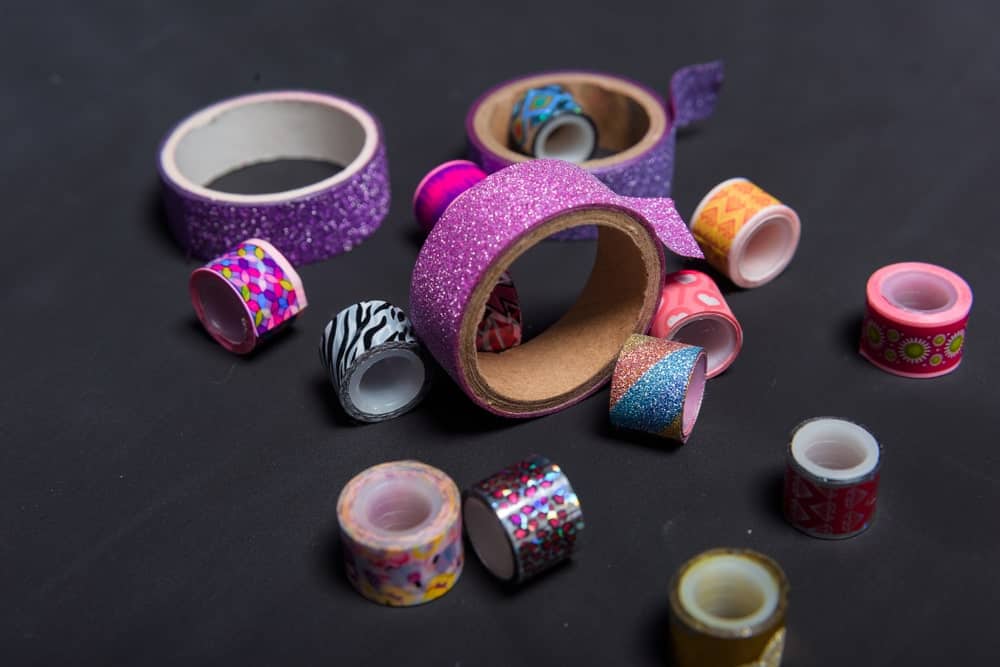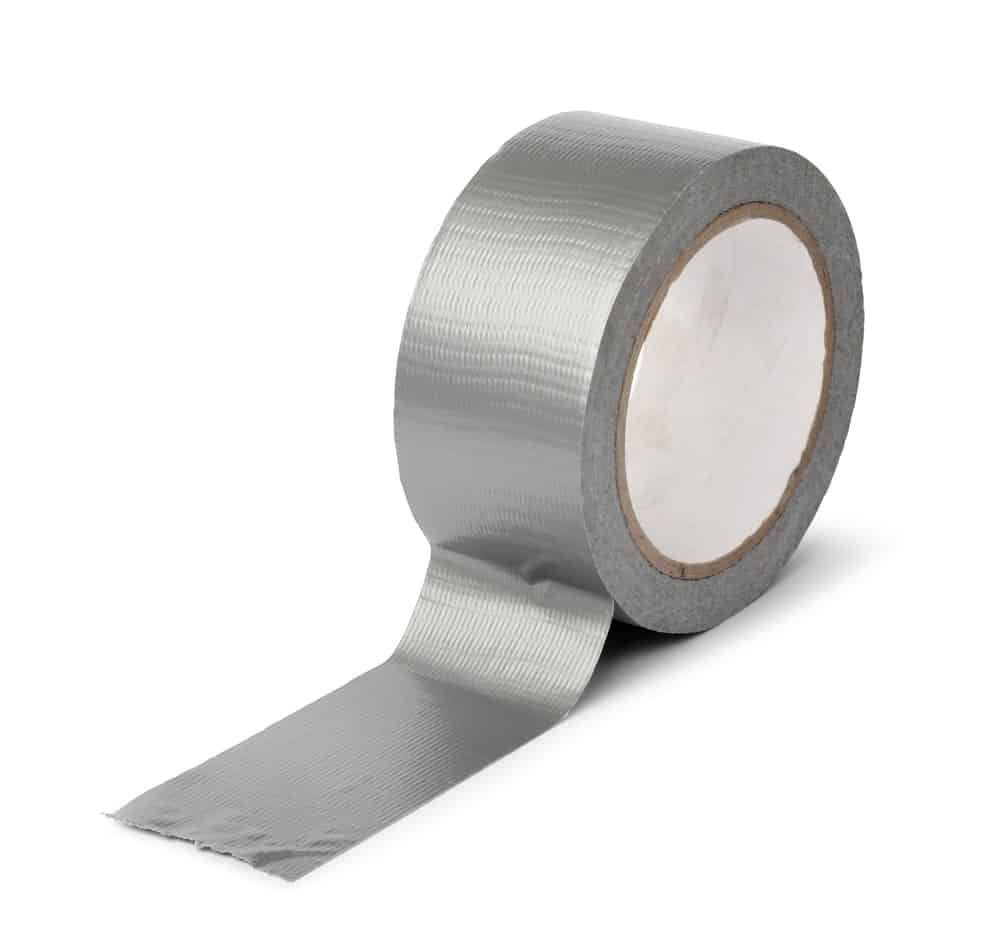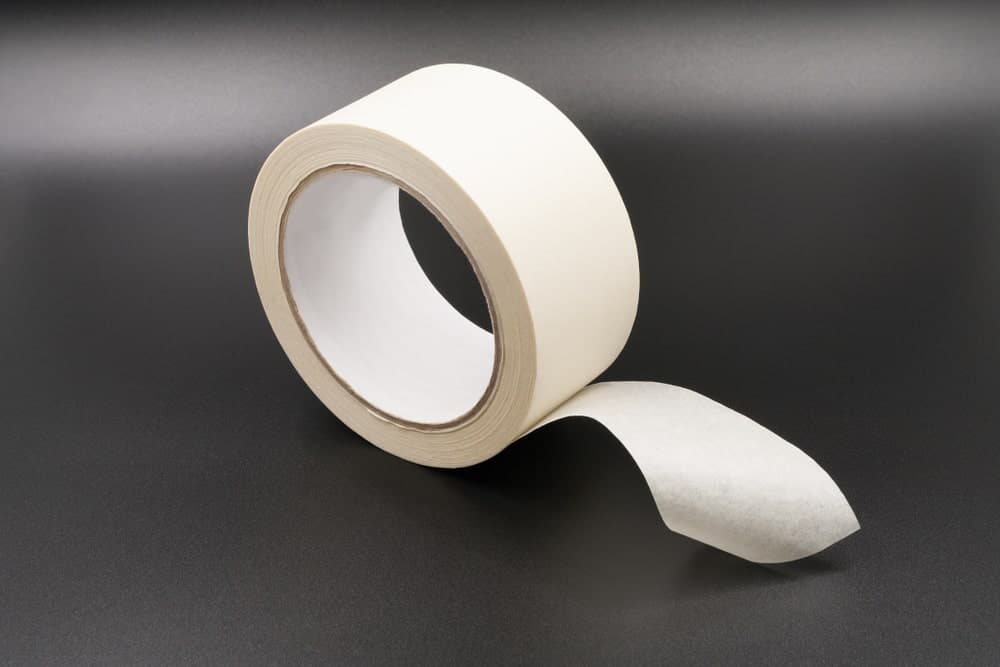Before there was tape, the early humans mended the earthenware pots using an adhesive substance from tree saps. The first tape ever invented was the surgical tape by Dr. Horace Day in 1845. The band-aid was next invented in 1921 by Earle Dickson who attached gauze to a cloth-backed tape covered with crinoline.
Four years later, Richard Drew invented the first masking tape as a solution to the auto painters’ dilemma of making clean dividing lines on two-color paint jobs. The duct tape was also borne out of necessity during World War II when the military needed waterproof tape as a sealer and to repair their equipment.
Basic Types of Tape
Adhesive Tape

Although regular adhesive tape is one of the most common tape available today, that does not mean that all of them are alike. Many people call this type of tape “Scotch tape” for the brand that is most common, but many reputable companies make high-quality adhesive tape for various uses. Adhesive tape can be as narrow as ¾-inch and as wide as 3 inches, and it is most often sold in rolls that allow you to use what you need and save the rest for later.
Adhesive tape is clear most of the time, but other varieties include matte, glossy, repositionable, double-sided, transparent, and even tape with fibers in it to make it a little stronger. This is also one of the least expensive types of tape you can purchase, and you can use it for everything from wrapping a present to repairing a tear in a piece of regular or construction paper.
Most people associate basic adhesive tape with tape used by office workers or gift-wrappers, but since the tape is so strong and reliable, you can use it for just about anything nowadays. The fact that it comes in so many sizes is a guarantee that you will always find exactly what you are looking for when you need a good roll of adhesive tape.
Cloth Tape

Tapes made out of cloth or fabric usually are used for medical purposes, and, therefore, they are always found in hospitals and medical clinics. The cloth is strong, but it still allows the tape to be removed whenever necessary. It is often used to secure splints, bulky dressings, gauze, and even other types of bandages. They come in widths from ¾-inch to two inches and are usually made in rolls.
They also tear easily, making it simple and fast to get the exact size you need. They are hypoallergenic, in part because they do not include natural rubber latex, they stick securely while still allowing you to remove them easily, and they are very breathable, which means they are extra-comfortable. Cloth tapes can even support fingers and wrists without a splint or bandage, and they are the most commonly used tapes in hospitals.
In addition to medical purposes, cloth tape is also used for a variety of crafts projects. Crafters use cloth tape for many sewing, book-binding, and general craft projects, including tagging or marking fabric, holding a seam in place, and many others. Construction workers also use cloth tapes for projects such as sealing up walls, and in various types of duct and heating work.
Because cloth tape comes in a wide variety of sizes and even colors, electricians, plumbers, and many other types of professionals use them regularly in their work. Some cloth tape, like the type used often by plumbing professionals, is even waterproof, and the cloth tape used for crafts can come in virtually any color you can think of, including hot pink and neon green.
Decorative Tape

Decorative tape can be duct tape, painter’s tape, or even basic adhesive tape, but it is the tape that comes in various colors and designs and which is usually used for various art projects or even to wrap up a present. You can find duct tape, for example, in a wide variety of patterns that include dark and light colors, and prints that include balloons, flowers, geometric designs, letters or numbers, and even ice cream cones, soccer or footballs, stripes, animals, and polka dots. In fact, whatever you are looking for, you can likely find it when you want some type of decorative tape for an arts and crafts project.
Many arts and crafts enthusiasts use these tapes for projects that include decorating writing pens, wrapping the ends of artificial flowers to make them more eye-catching, covering light switch covers, covering a vase or a wreath, and embellishing items such as bookends, picture frames, and even wreaths.
Double-Sided Tape

Double-sided tape is very versatile and is used by everyone from professional scrapbookers to amateur craft-lovers. It is specially designed to stick on both sides; for example, if you wish to add something to a piece of paper, such as a smaller item that does not cover the entire page, you can do so with double-sided tape. They make two basic types of double-sided tape.
The first one sticks on both sides and is designed to have a more permanent adhesion on both sides; this kind is usually a type of basic adhesive or “Scotch” tape. The other is one that has less adhesive on one of the sides, and, as a result, it is easy to remove it when desired. This type of double-sided tape is great for hanging posters or prints on a wall, and it is designed such that you can remove it easily without damaging the walls.
Double-sided tape can be either regular, clear, adhesive tape, or it can be made of a type of foam that provides a bit of cushioning as well as the ability to stick both to walls and to other objects. The latter is mostly used for pinning up posters or prints on walls, and when you are ready to remove them, the walls will be as clean and clear as they were before you put them up with the tape. There are other types of double-sided tape that are used for various industrial jobs, and these can be found in stores that specialize in wholesale or industrial-type products.
Duct Tape

Duct tape is a very strong, all-purpose adhesive tape that is also waterproof. There are hundreds of products that can be made more successful with the use of duct tape, and because duct tape now comes in a wide variety of sizes and colors, you can choose any type you like for the project at hand.
One of the biggest advantages of duct tape is that it is both very strong and versatile, and it is also flexible enough to be used for a variety of projects. People have used duct tape to make purses, wallets, artificial flowers, backpacks, ornaments, and covers for textbooks; not to mention its usefulness in decorating – thanks to the various colors available – items such as jars, popsicle sticks, wrapping paper, bookmarks, and tote bags.
Through the years, duct tape has been used for many very unique purposes, including repairing a leaky boat, making furniture for dollhouses, making clothing and even toys, covering up holes in shoes or clothing, repairing a smashed or cracked windshield, and even taping small objects and toys to walls. If you think hard enough, you can come up with a variety of things to repair, make, or create with duct tape. It is inexpensive, and you can use it for more than just one or two jobs.
Electrical Tape

As its name implies, this type of tape is used mostly by electricians to cover and insulate wiring and other electrical items. Electrical tape is an insulated type of tape that is usually made of either plastic, vinyl, or even cloth made of fiberglass. Electrical tape stretches very well and has insulation qualities that are very efficient and long-lasting. It is usually color-coded with colors such as black, red, blue, brown, orange, yellow, green, green with yellow stripes, white, and grey.
Each color has a specific usage and varies when it comes to characteristics such as low- or high-voltage, earth- or isolated-ground, Phase A, B, or C, and other characteristics having to do with insulation. Professional electricians are familiar with these colors because they are established either by the government or the underwriting laboratories that control them. They are the same regardless of where you purchase the tape.
Electrical tape is used to insulate electrical wires because this is the perfect way to prevent electrocution and short circuits. However, there are many other possible uses as well, including wrapping it around bare electrical wires in a coil-like shape in order to keep out condensation and moisture.
In addition, non-electricians have used electrical tape, in part because it is easy to tear and stretch, for tasks such as tying together loose cables, marking positions for actors on a stage, keeping shin-guards in place for athletes, and protecting musician’s hands from blisters while playing instruments. You can also use the tape to label food containers, and you can even make temporary bandages with it in an emergency.
Magnetic Tape

Magnetic tape is usually sold in cassette and cartridge form, but it was originally sold in reels. The tape is used for storing data, and is it composed of plastic. One side of the tape has a ferromagnetic coating, and it normally has tracks running parallel to the edge for linear recording. Some magnetic tapes also have diagonal tracks. With all types of magnetic tape, the storage capacity is now quite large, unlike it was in the past.
The only drawback to magnetic tape is that it must be re-copied periodically because if the magnetic surfaces come into contact with one another, it could ruin the tape. Another disadvantage to using magnetic tape is that it is often very difficult to find the information you are looking for, so, if you need to archive material that you will be referencing often, this is definitely not the type of tape you should use.
There is also another type of magnetic tape, and it is used for labeling products and many other things. This type of tape is usually white on one side and has magnetic capabilities on the other side. As a result, you can write something on the white side, and place the magnetic side of the tape on objects such as storage boxes, signs, walls, and many other items, as long as they are magnetic themselves.
The biggest advantage of these magnetic tapes is that they come in a wide variety of thicknesses, widths, and even shapes, and the magnetic material is flexible and usually coated for extra strength. Many companies that sell this type of tape are industrial in nature, but a quick Internet search can lead you to the right company if you are interested in the product.
Masking Tape

Masking tape can also be called painter’s tape, and when it is used for painting it is usually blue in color. Masking tape is thin and pressure-sensitive, and it is made of a type of paper that is very easy to tear. It is also easily released thanks to its pressure-sensitive adhesive. Masking tape comes in a variety of sizes and colors, and, if you are painting, you can easily mark off the areas you do not want to be painted.
Once the painting is finished, you can tear the tape off. Because of its materials, masking tape does not mark up the walls or smear the surrounding paint. In addition, because of its temporary nature, this tape is not good for items that need permanent tape placed on them; in other words, if you are wrapping a package to mail to someone, do not use masking tape, but instead, use something specifically for packages.
In addition, masking tape can be used to mark up the body of your vehicle when you want a two-tone paint job done, to label food and school supplies, to make a race track on the floor for tiny toy cars, to tape up a vacuum cleaner bag so you can reuse it, to hang streamers for your next birthday party, to repair a broken umbrella, and to cover the rims of your paint cans to keep them neater. Every day, people seem to come up with more unique ways to use masking or painter’s tape, and the flow of ideas is not likely to end anytime soon.
Mounting Tape

Mounting tape is a type of double-sided adhesive tape, and it is made of foam and used to hang items on a wall or other surfaces. One side of the backing is peeled off of the tape and stuck to the item you wish to hang, while the other side is peeled off so that it can be placed on the wall. Although mounting tape is usually meant to be removable, there are some types that are permanent.
This is why, if you are researching or intend to purchase any type of mounting tape, you should carefully read the description on the packaging so that you do not accidentally get the wrong type. If you do choose the permanent type of mounting tape, it is crucial that you determine the exact placement of the item before you remove the backing from the tape. Some types of mounting tape have to pull strips that allow you to take the items off the wall without destroying the wall, while others do not. It is vitally important that you know which type of tape you have before you use it.
Another advantage of mounting tape is that it comes in many different weights and widths, with the heaviest type being able to hold up to two pounds. Some come in rolls that allow you to cut the exact size you need, while other types come in pre-cut sizes. Most mounting tape can be used on a variety of surfaces, including walls, glass, mirrors, and even tile.
You must read the directions as they will explain the intended use of your tape in detail. This way, there will be no disappointments once you start to use it. Mounting tape is also made for both indoor and outdoor use, so once you start to look around for this type of tape, you are all but guaranteed to find just what you need.
Packaging Tape

Packaging tape is usually clear or light-colored. It is used to seal up packages in a permanent manner so that they can get to their destination safely and without ripping or tearing. In fact, because of packaging tape’s strength and durability, it is very often used to wrap not only all types of fiber and cardboard boxes, but also to seal various items such as bottle caps, pill containers, and food containers.
It can also enclose items grouped together in a protective liner or film, and seal many other types of storage containers. It can be cut open with a sharp knife, but it is permanent enough to keep the storage container in one piece until it gets to its final destination.
Materials
BOPP – Biaxial-Oriented Polypropylene
This material is what packing tape is usually made of, and it is a thermoplastic polymer, meaning it is pliable above a certain temperature and also returns to a solid-state after it cools down. BOPP is a type of polypropylene and does great not only in packing tape, but also for labels, stickers, textiles, and many different types of plastic parts and materials. Its strength and durability make it the perfect material for these items, as well as many others.
Cellophane
Many basic adhesive tapes, including those which are used for wrapping presents, are made of a type of cellophane, which is moisture-proof and works great as a backing for tapes that need to be pressure-sensitive. The companies that make this type of tape add oils, rubber, and various resins to the cellophane to make sure it does not curl or yellow, and they also use a special heat-sealing process to make sure it works without falling apart.
Cloth-Backed
Tapes such as duct tape are cloth-backed tape and usually have three separate layers. These layers include a layer of polyethylene plastic, a fabric or cloth mesh layer, and a pressure-sensitive, rubber-based adhesive layer. All three of these items are strong and durable, yet flexible enough for the tape to be used in a variety of projects.
Foam
Double-sided tape that is used to pin posters up on a wall is often made of a foam material. The tape has a polyethylene, closed-cell foam material on one side and a rubber, adhesive-like material on the other side. This type of tape usually has a tensile strength of six pounds per inch, and it can withstand temperatures up to 150 degrees Fahrenheit. There are other qualities of foam tape besides these, however, and the type you choose will depend on whether you need it for basic home use or for heavy-duty industrial use.
Miscellaneous Backing Materials
The backs of tapes can be made out of a variety of materials, including:
- Copolymer plastic film
- Flatback paper
- Paper
- Polyethylene
- Polyethylene and crepe mixed together
- Polyethylene over cloth
- Polypropylene
- Vinyl
Tape such as masking or painter’s tape can be made with most of the above materials, and each of them offers the advantages that certain customers are looking for.
Vinyl
A lot of tapes is made out of vinyl, and usually, two types of ingredients are used in the vinyl. The first is chlorine that comes from salt, and the second is ethylene that comes from natural gas. Vinyl can be made either in rigid form, usually for products such PVC pipes, in semi-liquid form, or inflexible form. Electrical tape is a perfect example of flexible vinyl, but other ingredients can sometimes be used in this type of tape. These include ingredients such as resin and esters, the latter of which is a chemical compound.

